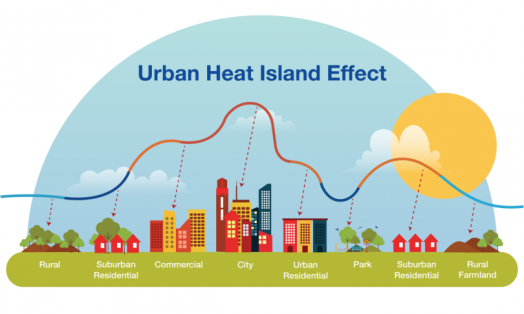Exploring the Role of EVs in Mitigating Urban Heat Islands
Introduction
Urban Heat Islands (UHIs) are a growing environmental concern in cities worldwide. These regions experience significantly higher temperatures than their rural counterparts due to dense infrastructure, reduced vegetation, and heat-absorbing surfaces like asphalt and concrete. With rising global temperatures and rapid urbanization, finding sustainable solutions to combat UHIs is crucial. One promising approach involves the widespread adoption of electric vehicles (EVs), which can play a vital role in reducing urban temperatures and improving overall environmental quality.
Understanding Urban Heat Islands
Urban Heat Islands form primarily due to the following factors:
- Heat-absorbing materials: Traditional roads, buildings, and pavements retain heat and radiate it back into the environment.
- Lack of vegetation: Green spaces help cool the environment through shading and evapotranspiration, but urban areas often lack sufficient plant cover.
- Waste heat from vehicles and industries: Internal combustion engine (ICE) vehicles generate significant waste heat, contributing to localized warming.
- Dense urban structures: Skyscrapers and closely packed buildings trap heat, reducing airflow and exacerbating temperature rise.
How EVs Help Mitigate Urban Heat Islands
EVs offer multiple benefits that can help reduce the intensity of UHIs:
1. Lower Heat Emissions
Unlike gasoline and diesel vehicles, EVs do not produce direct tailpipe emissions. Traditional ICE vehicles generate substantial waste heat through combustion processes, which adds to urban temperatures. EVs, powered by batteries, operate more efficiently and emit significantly less residual heat, thus reducing localized warming effects.
2. Integration with Renewable Energy
EVs are most effective when charged using renewable energy sources such as solar and wind. Cities can integrate solar-powered charging stations, reducing dependence on fossil fuels and minimizing overall heat output from power generation facilities.
3. Promoting Green Infrastructure
Many cities are redesigning urban landscapes to accommodate EV-friendly infrastructure, such as dedicated EV lanes, solar-panel-covered charging stations, and green parking spaces with tree cover. These initiatives help in reducing heat-absorbing surfaces and enhance cooling effects.
4. Advancing Smart Grid and Energy Efficiency
EVs can be integrated into smart grids with vehicle-to-grid (V2G) technology, enabling stored energy from EVs to be used during peak demand hours. This reduces stress on power plants, which often contribute to heat emissions in urban areas. A well-managed energy system with EVs can lead to overall lower urban temperatures.
5. Encouraging Sustainable Urban Planning
The rise of EV adoption encourages city planners to rethink infrastructure with sustainability in mind. Expanding pedestrian-friendly zones, bike lanes, and public transport options alongside EVs fosters a holistic approach to reducing heat-retaining urban environments.
Challenges and Considerations
While EVs present a promising solution, some challenges must be addressed to maximize their effectiveness:
- Battery Production Impact: The production of EV batteries involves energy-intensive processes, which can contribute to heat emissions if not managed sustainably.
- Charging Infrastructure Expansion: To encourage EV adoption, widespread and efficient charging infrastructure must be developed, which requires careful urban planning.
- Electric Grid Load: A surge in EV adoption can strain existing power grids, necessitating investments in renewable energy and smart grid technologies.
Conclusion
Electric vehicles play a crucial role in mitigating urban heat islands by reducing waste heat emissions, integrating with renewable energy, promoting green infrastructure, and supporting sustainable urban planning. While challenges exist, with proper policies and infrastructure investments, EVs can significantly contribute to cooler, more livable cities. As cities worldwide strive to combat climate change, embracing EVs as part of a broader sustainability strategy will be key to reducing urban temperatures and improving overall quality of life.
